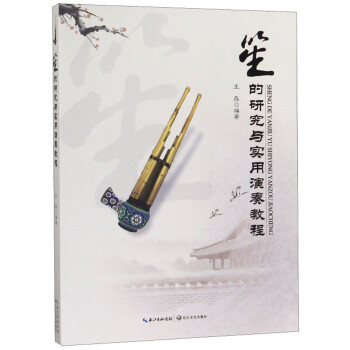The Study of Sheng and Practical Performance Course
overview of works
讲解了持笙方法、演奏姿势、笙的常用演奏技巧,收集、整理了笙的经典独奏曲目。
work details
"Study of Sheng Research and Practical Performance Course" not only explains the holding method, playing posture, and common performance skills (hands, mouth) of Sheng, but also creates, transplants and adapts the materials based on familiar folk songs, operas and foreign music. Sheng works, collected and sorted out the classic solo pieces of Sheng, and added the 36-reed Fang Sheng exercises and solo pieces that are widely used by front and foreign orchestras to better improve the practicability of this tutorial.

About the Author
Wang Lei, contemporary young sheng performer, associate professor of the Central Conservatory of Music, tutor of postgraduate students, director of the Band and Chamber Music Teaching and Research Section of the Department of Folk Music. Member of the Chinese Musicians Association, executive director of the Sheng Professional Committee of the Chinese National Orchestra Society. China's first Dr. Sheng (currently studying), under the tutelage of Professor Yang Shoucheng and Professor Lin Chongzeng.
content
Chapter 1 Overview of Sheng
Section 1 The historical origin of Sheng
Section 2 Types of Sheng
1. Common types of Sheng
2. Contemporary Improved Sheng
Section 3 Phonemic Fingering Diagram, Playing Posture and Ways of Holding the Sheng
1. Phonemic fingering chart of 24-reed traditional Sheng and 36-reed square Sheng
2. The traditional 24-reed sheng playing posture and the method of holding the sheng
3. Playing posture and holding method of 36-reed square sheng
Section 4 Construction and Maintenance of Sheng
First, the basic structure of Sheng
Second, the maintenance of Sheng
Section 5 Playing Symbol Table
Chapter 2 Traditional Sheng Parts
The first method of breathing
1. Exhale
2. Inhale
Section 2 Commonly Used Modes
1. D key
2. G key
Three, C
4. A key
Section 3 Mouth Skills
1. Tone
Second, sigh
3. Saw gas
4. Vibrato
Five, tongue
Six, flower tongue
Seven, tongue
Eight, spit
chapter 4 hand skills
1. Shaking fingers
Second, the calendar
3. Play the sound
4. Portamento
5. Two-part performance
Chapter 3 Part of the 36 Spring Fangsheng
Section 1 Common Modes
1. C major and relative minor
2. G major and relational minor
3. D major and relative minor
4. A major and relational minor
5. F major and relational minor
6. bB major and relational minor
7. bE major and relational minor
Section 2: Touching the keys and pressing the fingers
1. Single-tone touch key pressing practice
2. Harmony touch key pressing practice
Chapter 4 Sheng Solo and Ensemble Works
Section 1 Traditional Sheng works
1. Escape
Second, the passion
Three, free flower
4. The Path
Five, divination
Six, Sheng · sound curtain
Section 2 36 Spring Fangsheng Works
1. Tianwuwu
2. Green - Pure Fifth Practice Sheng
3. The Spring of Eluanbi
Fourth, the river
5. Flying bees
6. GATEKEEPERS (gatekeeper)
7. Impression of Kampong
The third ensemble
1. Cottage style
2. Prairie Chunhui
Three, Gal
Four, the letter leaf love
5. Rainbow
 渝公网安备 50010702504639号
渝公网安备 50010702504639号